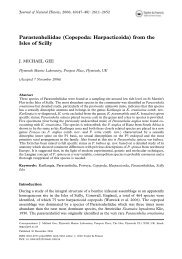An Updated Classification of the Recent Crustacea
An Updated Classification of the Recent Crustacea
An Updated Classification of the Recent Crustacea
Create successful ePaper yourself
Turn your PDF publications into a flip-book with our unique Google optimized e-Paper software.
logeny and taxonomy. This focus on ‘‘. . . animals<br />
that work . . .’’ is directly lifted from <strong>the</strong> later writings<br />
<strong>of</strong> Sidnie Manton. Schram (1993, The British<br />
School: Calman, Canon, and Manton and <strong>the</strong>ir effect<br />
on carcinology in <strong>the</strong> English speaking world;<br />
<strong>Crustacea</strong>n Issues 8:321–348) outlined <strong>the</strong> roots <strong>of</strong><br />
Mantonian reasoning in an idealist philosophical<br />
tradition that passed on through Thompson and his<br />
treatise On Growth and Form. This is essentially a<br />
Platonic view <strong>of</strong> comparative biology, and stands<br />
essentially at odds with <strong>the</strong> current emphasis, ei<strong>the</strong>r<br />
a priori or a posteriori, on elucidating ground<br />
plans. You are <strong>of</strong> course free to quote Fryer, but<br />
you ought to give fair play to alternative philosophical<br />
and conceptual foundations for systematics.<br />
Submitted by Frederick R. Schram,<br />
Zoölogisches Museum, Amsterdam<br />
BRANCHIOPODA: ANOSTRACA<br />
Weekers et al. (in press) examined small subunit<br />
ribosomal DNA <strong>of</strong> anostracans from 23 genera belonging<br />
to eight <strong>of</strong> <strong>the</strong> nine families recognized by<br />
Brtek (1997). Their results do not support <strong>the</strong> family<br />
Linderiellidae or Polyartemiidae. Instead, <strong>the</strong>y<br />
group Linderiella with Polyartemia and Polyartemiella<br />
as a subfamily <strong>of</strong> <strong>the</strong> family Chirocephalidae.<br />
Morphological considerations support this arrangement<br />
in that <strong>the</strong> three genera share rigid antennal<br />
appendages on o<strong>the</strong>rwise simple antennae and double<br />
pre-epipodites. Unfortunately, <strong>the</strong>se workers<br />
were not able to obtain usable Artemiopsis. Thus,<br />
<strong>the</strong> validity <strong>of</strong> Artemiopsidae remains untested by<br />
molecular methods; however, I continue to consider<br />
that <strong>the</strong> morphology <strong>of</strong> <strong>the</strong> penes places Artemiopsis<br />
in <strong>the</strong> family Chirocephalidae.<br />
Additional References<br />
Weekers, P. H. H., G. Murugan, J. R. Vanfleteren, and H.<br />
J. Dumont. In press. Phylogenetic analysis <strong>of</strong> anostracans<br />
(Branchiopoda: <strong>An</strong>ostraca) inferred from<br />
SSU rDNA sequences. Molecular Phylogenetics and<br />
Evolution.<br />
Submitted by Denton Belk,<br />
Our Lady <strong>of</strong> <strong>the</strong> Lake University,<br />
San <strong>An</strong>tonio, Texas<br />
REMIPEDIA<br />
See comments from G. Boxshall under Maxillopoda<br />
and from M. Christ<strong>of</strong>fersen under <strong>Crustacea</strong>.<br />
REMIPEDIA<br />
In <strong>the</strong> section about <strong>the</strong> Remipedia, you mention<br />
that <strong>the</strong> similarities between <strong>the</strong> Maxillopoda and<br />
<strong>the</strong> Remipedia are symplesiomorphies. But what<br />
are <strong>the</strong>se? The only similarities I can think <strong>of</strong>, I<br />
would not consider as symplesiomorphies, but perhaps<br />
as convergences. Perhaps it is unwise to mention<br />
something like this without also mentioning<br />
<strong>the</strong> characters. The first question people will raise<br />
is what <strong>the</strong>se characters are. In <strong>the</strong> same section<br />
you use <strong>the</strong> term ‘basal’ about branchiopods, but<br />
what does that actually mean? There are two possibilities,<br />
ei<strong>the</strong>r early <strong>of</strong>f split (e.g., sister group) or<br />
primitive (or at least with many primitive features),<br />
but <strong>the</strong>se are two different things, as addressed earlier.<br />
Submitted by Jørgen Olesen,<br />
University <strong>of</strong> Copenhagen, Denmark<br />
CEPHALOCARIDA<br />
In <strong>the</strong> section about <strong>the</strong> Cephalocarida, you say<br />
that <strong>the</strong> sequence <strong>of</strong> <strong>the</strong> classes reflects something<br />
(it doesn’t matter exactly what in this context). My<br />
problem here is that I don’t think that <strong>the</strong> sequence<br />
<strong>of</strong> taxa <strong>of</strong> equal rank in a classification reflects anything.<br />
If a classification shall reflect anything concerning<br />
relationship, it has to be put into <strong>the</strong> hierachical<br />
categories (like you have done for <strong>the</strong> classification<br />
within <strong>the</strong> Branchiopoda, for example). I<br />
think this is an old way <strong>of</strong> thinking with no meaning<br />
today.<br />
Submitted by Jørgen Olesen,<br />
University <strong>of</strong> Copenhagen, Denmark<br />
MAXILLOPODA<br />
The status <strong>of</strong> <strong>the</strong> Maxillopoda remains uncertain. I<br />
consider that <strong>the</strong>re is a group <strong>of</strong> related taxa which<br />
form <strong>the</strong> core <strong>of</strong> a Maxillopoda: <strong>the</strong>se are <strong>the</strong> Copepoda,<br />
Thecostraca, Tantulocarida and Ostracoda<br />
(excluding <strong>the</strong> Phosphatocopines which are not ostracods<br />
and do not even belong to <strong>the</strong> crown group<br />
<strong>of</strong> <strong>the</strong> <strong>Crustacea</strong>). The Mystacocarida and Branchiura<br />
may also belong to this group but <strong>the</strong> available<br />
supporting evidence is weaker. I also consider<br />
that <strong>the</strong> Remipedia is related to <strong>the</strong> maxillopodan<br />
lineage. Remipedes share several derived features <strong>of</strong><br />
<strong>the</strong> thoracopods, maxillules and maxillae with o<strong>the</strong>r<br />
maxillopodans as indicated in my paper on comparative<br />
musculature (Boxshall, 1997).<br />
Additional References<br />
Boxshall, G. A. 1997. Comparative limb morphology in<br />
major arthropod groups: <strong>the</strong> coxa-basis joint in postmandibular<br />
limbs. In Arthropod relationships, eds.<br />
R. A. Fortey and R. H. Thomas, 155–167. London:<br />
Chapman and Hall.<br />
Submitted by Ge<strong>of</strong>f Boxshall,<br />
Natural History Museum, London<br />
MAXILLOPODA<br />
I really understand your difficulties here. To cut <strong>the</strong><br />
message short, I think you should have chosen to<br />
include <strong>the</strong> component taxa <strong>of</strong> <strong>the</strong> Maxillopoda as<br />
classes and <strong>the</strong>n skip <strong>the</strong> ‘Maxillopoda’ (as you also<br />
almost decided to, I can see from your writing).<br />
I know you [are trying] to be conservative by<br />
following Bowman and Abele here, but actually, to<br />
be real conservative you should skip that level. This<br />
Contributions in Science, Number 39 Appendix I: Comments and Opinions 105











